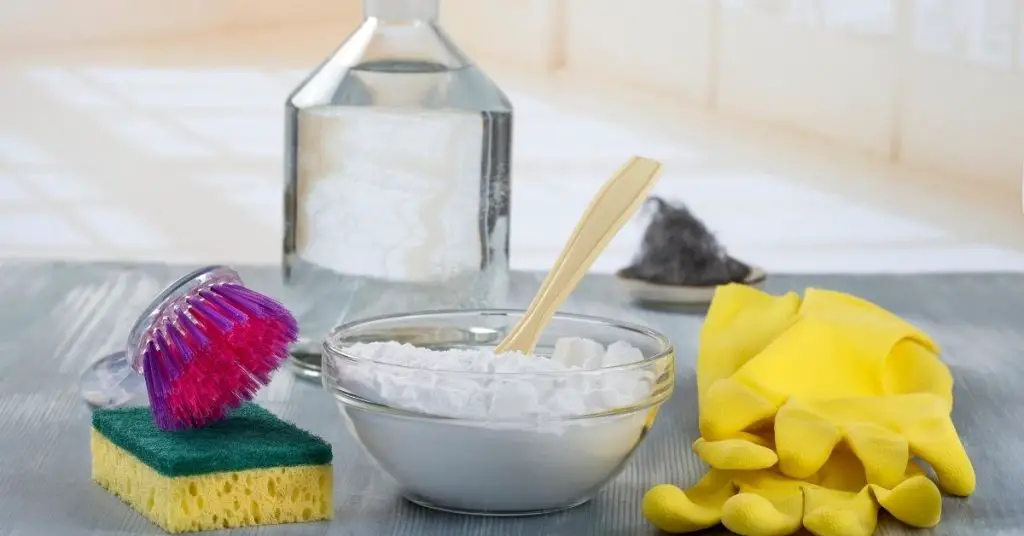Using Sodium Bicarbonate in Household Cleaning
Baking soda is an affordable multi-purpose cleaning solution that’s effective in multiple household chores.
Before manufacturers began producing chemical household cleaners, humans developed intelligent routines and cleaning hacks that pass down through generations.
Using baking soda, or bicarbonate of soda, for all types of polishing, scrubbing and unblocking is one of them.
It’s safe to say that since people have been using bicarbonate of soda for cleaning their homes for centuries, there must be something that’s working.
When searching for a cleaning remedy, you’re almost guaranteed to find a suggestion that involves baking soda and or vinegar.
A lot of cleaning products nowadays actually include bicarbonate of soda as an ingredient.
In this post, we’ll be looking into what bicarb of soda is, why it works for cleaning and the various ways you can include it in your household routine.
Why Is Bicarbonate of Soda Good for Cleaning
Before we go into why baking soda works for cleaning, let’s first break down what it is so we can look deeper into what’s going down at a molecular level.
What is it?
Bicarbonate of soda’s intended use is as a raising agent in bread and cakes as an alternative to yeast.
The science
Baking soda is an alkali, so to activate it, there needs to be an acid present. In food, this is commonly cream of tartar, milk, or yoghurt. In cleaning, we might use vinegar or lemon juice to cause the same raising effect.
Once the reaction occurs, the bicarb and acid mixture will expand by filling with carbon dioxide (CO2) and creating a foamy substance.
You may have seen this reaction in a classroom. Check out these science experiments to see the power these two simple ingredients can have.
Why Is it Good for Cleaning?
Neutralises Odour
Most odours are acids, so an alkaline will neutralise the substance bringing it closer to water and taking out the smells.
Naturally Abrasive
Baking soda has fine particles that can help with scrubbing off hard-wearing dirt.
Breaks Down Grime
Bicarbonate of soda is an alkali which means it is highly effective in dissolving grease and oils.
Most cleaning products designed to break down fats and grease are full of harsh chemicals which can be potentially damaging to skin and surfaces or harmful when inhaled.
Since baking soda is mild, it’s many people’s preferred option for cleaning the house.
Baking Soda or Bicarbonate of Soda for Cleaning
You will have noticed we are using baking soda and bicarbonate of soda interchangeably. That’s because they are, in fact, the same thing.
Whether you call it bicarbonate of soda like the Brits and Aussies, or baking soda in the US, we’re all talking about the same powdered substance.
However, using Baking Powder for cleaning won’t be as effective due to the presence of cream of tartar and other potential ingredients. It won’t do any damage but it’s essentially a diluted baking soda.
How to Use Bicarbonate of Soda to Clean
Most cleaning hacks involving baking soda will include making some form of a paste with vinegar, water or lemon juice.
They’ll probably also need a decent amount of elbow grease.
For some bigger household items, the process is slightly more complicated. We’ve split these items into their own categories to give more detailed instructions.
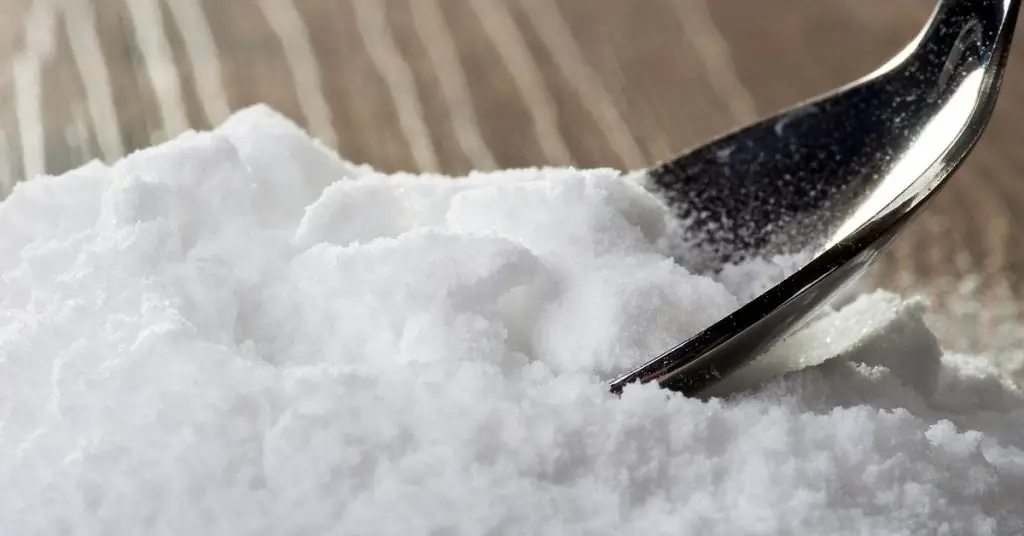
What should you not clean with baking soda?
Before we start suggesting things you can clean with bicarb, we want to warn you against items that can be potentially damaged by it.
A lot of things that shouldn’t ever be cleaned with baking soda are valuable, so it’s worth knowing what these are.
Although bicarb is a mild substance, there is still potential to harm surfaces depending on their chemical make-up.
Experts suggest that baking soda should not come into contact with:
- Cleaning Silver
The abrasive nature of bicarbonate of soda is too rough for silver and should be avoided (the same goes for gemstones).
Sterling silver may be okay, but we wouldn’t suggest risking it.
- Cleaning Marble
The rough particles in baking soda may wear down the sealant on marble countertops.
- Cleaning Aluminium
Be careful with which dishes you’re scrubbing as Items like pans or baking trays may be aluminium, which can end up discoloured or even rusted after being left in contact with baking soda.
- Anything Gold or Gold Plated
When washing up your fine gold-rimmed china or anything with any gold on it at all, definitely don’t reach for the baking soda.
Gold is a very soft metal. The abrasive texture of bicarbonate of soda can scratch, or even remove, the gold.
Bicarbonate of Soda for Cleaning Drains
- Loosen the grime and get things going by pouring a large pot of boiling water down the drain.
- Pour one cup of baking soda into the drain, followed by a mixture of one cup of vinegar and a cup of water.
- Cover up the drain pipe and wait for 5-10 minutes.
- Whilst you’re waiting, boil another pot of water.
- Once the time’s up, pour the second batch of boiling water down the drain.
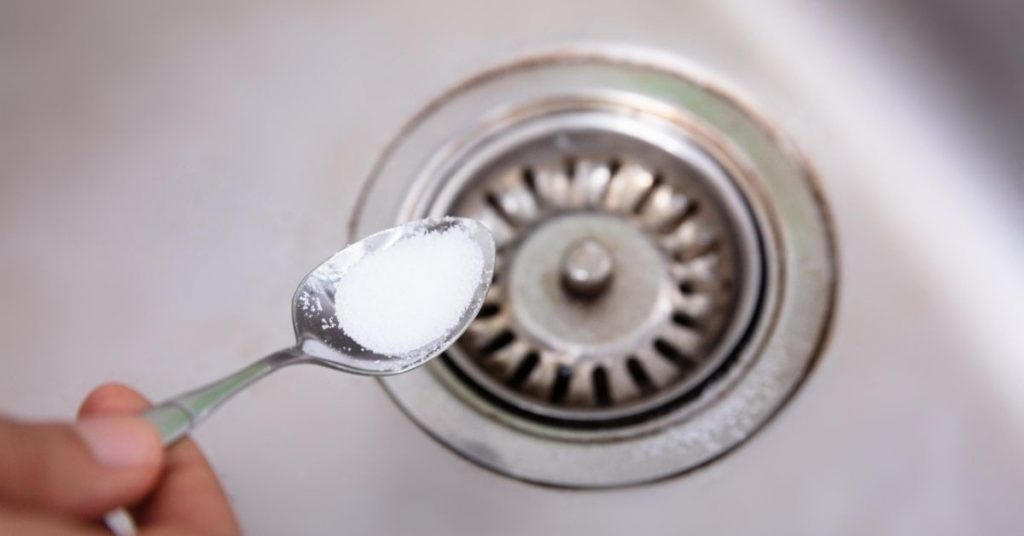
In step 2, the solution of baking soda and vinegar will cause a foaming reaction that gets into the grime in the pipes.
Remember making vinegary-smelling volcanoes in school? This cleaning remedy is the same reaction, minus the red food colouring!
The boiling water acts as a flush, that produces force and pushes out the built-up dirt.
If your drains are significantly blocked, you may need a more industrial unblocker to dissolve the dirt and trapped food.
Bicarbonate of Soda for Cleaning Ovens
How to Make a Bicarbonate of Soda Oven Cleaner
Ingredients:
- 90g or ½ cup of baking soda
- 2½ – 3 tablespoons or 35-55ml water depending on desired consistency
You will need:
- Any bowl or container (not aluminium)
- Rubber gloves
- Small spatula or flat scoop for spreading the paste
- (If you have any old spatulas that came with hair removal cream these work great for spreading on the thick paste.)
- Clean Toothbrush
- Cloth or paper towels
- Vinegar (optional)
Step One
- The very first step for cleaning your oven and all racks and trays will be making the bicarb paste.
- After you’ve made your paste, take out all the racks and baking trays in the oven and place on the side.
If you’re also cleaning these, spread the paste on any burnt bits or grease and rub in with your glove or use a spatula tool. Leave this to sit.
- If you aren’t cleaning your oven racks and baking trays, this is your step 1 after removing all the shelves and trays. Spread your paste on any problem areas of your oven first with a thick layer, and then use a thinner layer to do the rest. Avoid any heating elements but remember to coat the glass and shelf grooves.
- Leave the paste to sit for 15 minutes.
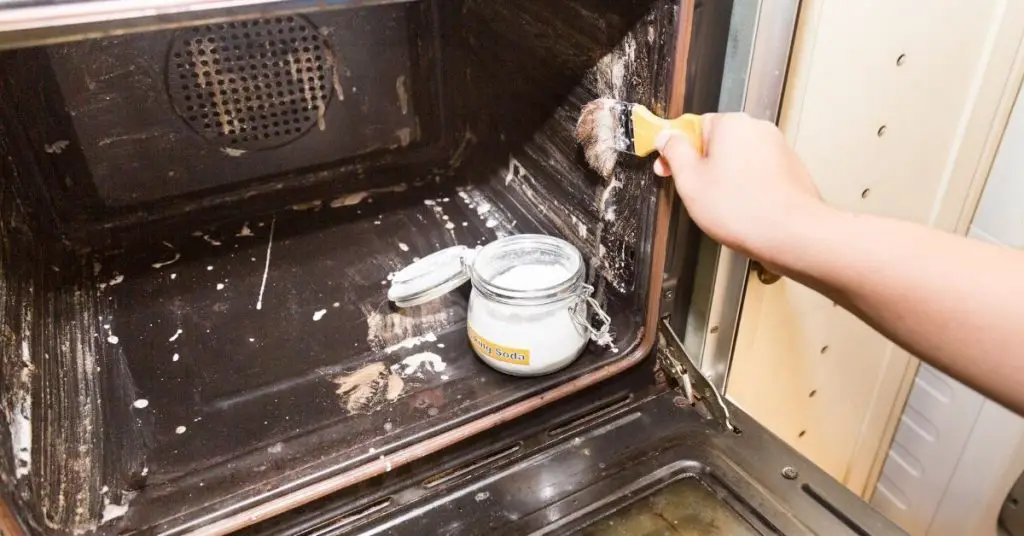
Step Two:
- Baking trays and racks step 2: At this point, your baking shelves and racks have probably had the solution on for 5-10 minutes.
Rub the mixture with a gloved finger and see whether the burnt bits are lifting off. If they are, you can use a scourer to remove the bicarb mixture and then rinse off in the sink.
If the dirt isn’t coming off, try using a scourer, toothbrush or a plastic spatula to scrub off the burnt bits, then rinse.
- Once the 15 minutes is up, see how well the oven grime is coming off by using your gloved finger to rub a small section.
If it’s lifting already, you can remove the paste with dry paper towels, followed by a wet cloth to remove any residue left over.
If the grime isn’t budging, you can leave the paste on for longer (overnight for stuck-on dirt).
Alternatively, you can try scrubbing at the stuck bits with a scourer, or utensil that can get under the hard grime without scratching at the glass or oven coating.
Once you’re satisfied with your oven, remove the paste with paper towels followed by wiping over with a wet cloth to remove any leftover residue.
| Top Tip: A neat trick to see if you’ve missed any is to wipe over the oven with vinegar. If any bubbling occurs, then there’s still some baking soda left over. This isn’t an essential step as baking soda is edible so won’t do any harm. |
How to Use Bicarbonate of Soda for Cleaning a Mattress
We won’t go into talking about all the nasties that are in our mattresses, but we will say that it’s worth giving them a good clean once in a while.
Cleaning your mattress with baking soda is a pretty easy job, but it’s worth doing in the morning and leaving on all day for the best results.
You only need a few items to clean a mattress, and you’ll probably have them at home.
- Vacuum cleaner – handheld or stair tool works well.
- Sieve
- Bicarbonate of Soda
- Using a sieve, sprinkle bicarbonate of soda all over your mattress with a focus on where the most dirt will be. If you accidentally pour too much just spread the powder around with your hand.
- Leave the powder for as long as possible – ideally the whole day. The baking soda absorbs any dirt, moisture out of the mattress as well as neutralising any odours.
- After you’ve left the sodium bicarbonate for as long as possible, use your vacuum cleaner to suck up all the powder.
Keep going after you think you’ve got it all to avoid clouds of white powder every time you jump on the bed.
- If you’re cleaning any liquid mattress stains, i.e. blood, make a thick paste of bicarbonate of soda and water and spread onto the stain. Leave the stiff paste on the stain for a few hours and then remove with a hoover or cloth.
- This stain removal technique will work best when the stain is fresh.
Follow this process to clean and deodorise any other soft furnishings, such as chairs and sofas.
How to Use Bicarbonate of Soda for Cleaning Carpets
Baking soda is a very neutral, natural product.
People have been using it to safely freshen up carpets and rugs, way before chemically manufactured liquid carpet cleaners were ever invented by a marketing department.
Baking soda on the carpet is safe and is an excellent deodoriser, but it doesn’t get rid of allergens or grime.
The only way it would have benefits in reducing allergens is that you have to give your floors and fabrics an extra-good vacuuming to suck up all the white dust.
If you’re looking to clean dirty carpets, we recommend cleaning stains and dirt as best as possible with your normal carpet cleaner.
You can then use baking soda to reduce any leftover odours in the carpet.
- Sprinkle baking soda all over the carpets and let it sit for as long as possible up to overnight.
- Remove all the bicarbonate of soda from your carpet with a vacuum cleaner.
- Enjoy your odour-free carpet!
Bicarbonate of Soda for Cleaning a Microwave
If your microwave needs a good clean, save your arm muscles and put your microwave to work.
- Simply use a microwave-safe bowl or mug and use two tablespoons of baking soda and add about 250ml or 1 cup of water, then mix them up.
- Place the bowl in the microwave for about 2-3 minutes depending on how dirty it is.
- The baking soda neutralises any stinky smells, and the water creates steam that loosens any dirt. Wipe down the inside of your microwave, and you’re done!
If you want, you add some lemon juice to the mixture as the lemon juice may add a pleasant smell and also work harder at removing the built-up grime.
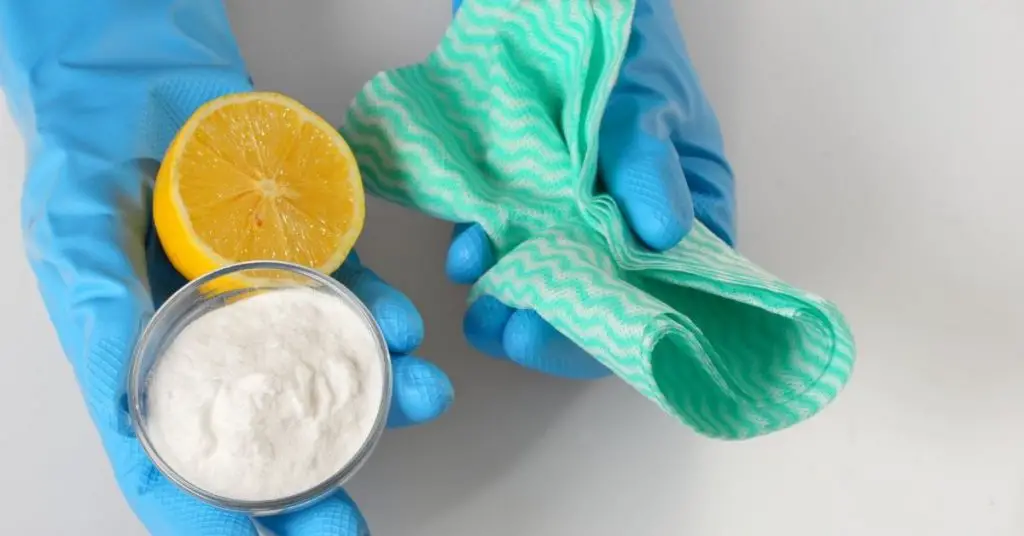
Ways to Use Baking Soda or Bicarbonate of Soda for Cleaning
Cleaning vases
Sprinkle some bicarb into your vase and add vinegar and warm water to cause a foaming reaction then scrub to remove any stain or gunk.
Clean your hairbrushes and combs
Soak combs and brushes in a mixture of 1 teaspoon of baking soda and 500 ml of warm water for an hour then rinse with water and leave to dry.
Soaking burnt pots and pans (not aluminium)
Leave a paste or liquid mix of bicarbonate of soda and hot water in any burnt pots and pans, leave for 20 minutes+, then scrub away.
Deodorising fabric
Sprinkle a layer of baking soda over your upholstery and leave as long as possible before vacuuming off.
Deodorising fridges and smelly cupboards
Put open containers of baking soda in fridges and underneath sinks to absorb bad odours and change once a month.
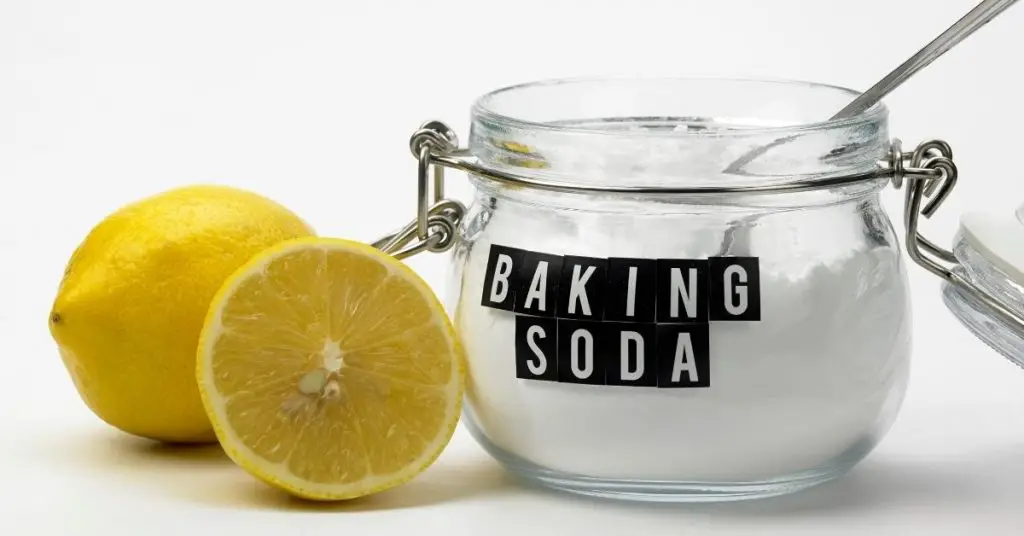
Where to Buy Bicarbonate of Soda for Cleaning
Where to Find Baking Soda in a Supermarket
Bicarbonate of soda is likely to be in the baking aisle in most supermarkets.
Where to Buy Baking Soda Online
Here are our Clean and Tidy Living favourites for online baking soda options.
Where to Buy Baking Soda in Bulk
Since baking soda is commonly using a teaspoon at a time in cooking, it can be challenging to know where to buy large quantities of baking soda.
If bicarb is going to become a key part of your household cleaning routine, it’s worth stocking up on the stuff.
Nortembio Bicarbonate of Soda – 3kg Bucket
Comes with a free e-book with 50 uses of Bicarbonate of Soda in the home!
Hexea Bicarbonate of Soda – 5kg Bucket
Hexea Bicarbonate of Soda – 10kg Bucket
The Round-Up of How to Use Bicarbonate of Soda for Cleaning
It’s safe to say that here at Clean and Tidy Living we are big advocates of using bicarbonate of soda for cleaning.
Not only is it effective in breaking down stains, grime and odours, but it’s also affordable and easy to get your hands on.
Also, if you’re not so keen on using chemicals in your home then it’s a great alternative to commercial cleaning products.
We hope that this guide to all things baking soda has been helpful in explaining what it is, how it works and how to use it.
Let us know in the comments how you use bicarbonate of soda in your cleaning routine! We’ll keep adding to the list with all your bicarb tips and tricks.
Related Cleaning Articles:
- Best Eco Friendly Cleaning Products In The UK
- How To Polish Porcelain Tiles And Make Your Floors Shine!
- How To Clean Stainless Steel Appliances With Baking Soda
- How To Descale A Kettle With Coke
- How To Clean Gas Hob Burner Caps
- How To Clean A Very Stained Toilet Bowl

